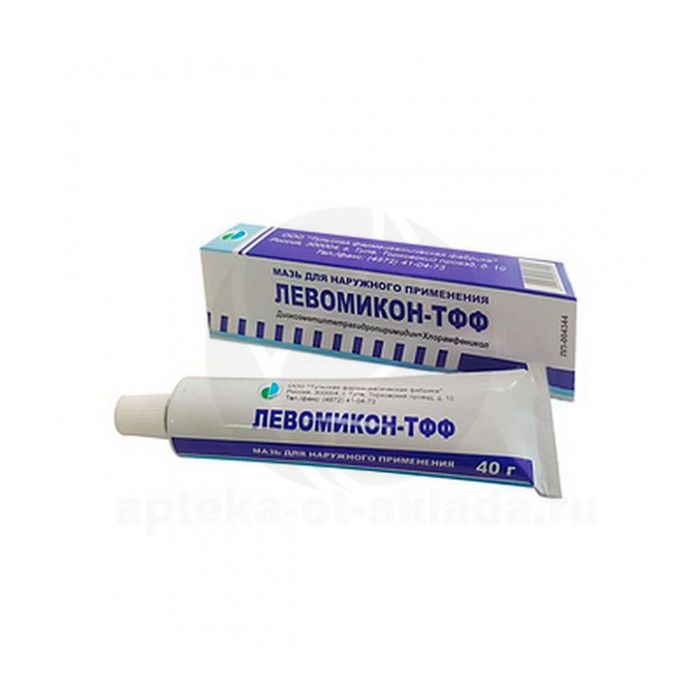Levomicon-TFF ointment for external use, 40g
Russian Pharmacy name:
Левомикон-ТФФ мазь для наружного применения , 40г
Purulent wounds (including those infected with mixed microflora) in the first (purulent-necrotic) phase of the wound process.
If necessary, please consult your doctor before using the medicinal product.
Outwardly.
The drug is impregnated with sterile gauze napkins with which the wound is loosely filled. It is possible to inject the drug into the purulent cavity through a catheter (drainage tube) using a syringe. In this case, the ointment is preheated to 35-36 ? C. Dressings are made every day, once a day until the wound is completely cleared of purulent-necrotic masses.
For large wound surfaces, the daily dose of the ointment in terms of chloramphenicol should not exceed 3 g.
The duration of treatment depends on the severity and course of the disease.
If after treatment there is no improvement or new symptoms appear, you should consult your doctor.
Use the drug only according to the method of administration and in the doses indicated in the instructions.
If necessary, please consult your doctor before using the medicinal product.
Active ingredients:
Dioxomethyltetrahydropyrimidine (methyluracil) - 4.00 g, chloramphenicol - 0.75 g;
Excipients: macrogol 1500 - 19.05 g, macrogol 400 - 76.2 g.
Hypersensitivity to drug components
children's age up to 1 year (in newborns, the biotransformation of chloramphenicol occurs more slowly than in adults).
Carefully:
Pregnancy lactation period.
Trade name of the drug
Levomikon-TFF
International non-proprietary name
Dioxomethyltetrahydropyrimidine + Chloramphenicol
Dosage form
topical ointment
Composition
Active ingredients:
Dioxomethyltetrahydropyrimidine (methyluracil) - 4.00 g, chloramphenicol - 0.75 g;
Excipients: macrogol 1500 - 19.05 g, macrogol 400 - 76.2 g.
Description
The ointment is white or white with a yellowish tinge.
Pharmacotherapeutic group
Combined antimicrobial agent
ATX code
D06C
Pharmacodynamics:
The combined preparation for external use has anti-inflammatory (dehydrating) and antimicrobial effects.
Chloramphenicol disrupts the process of protein synthesis in the microbial cell and belongs to antibiotics of bacteriostatic action.
It is active against gram-positive and gram-negative microorganisms (staphylococci of Pseudomonas aeruginosa and Escherichia coli, etc.).
Easily penetrates deep into tissues without damaging biological membranes. In the presence of pus and necrotic masses, the antibacterial effect persists.
Dioxomethyltetrahydropyrimidine, normalizing nucleic acid metabolism, stimulates regeneration processes in wounds, growth and granulation maturation of tissue; epithelization has an anti-inflammatory (dehydrating) effect.
Indications:
Purulent wounds (including those infected with mixed microflora) in the first (purulent-necrotic) phase of the wound process.
If necessary, please consult your doctor before using the medicinal product.
Contraindications:
Hypersensitivity to drug components
children's age up to 1 year (in newborns, the biotransformation of chloramphenicol occurs more slowly than in adults).
Carefully:
Pregnancy lactation period.
Pregnancy and lactation:
Use during pregnancy is possible only if the benefit to the mother outweighs the risk to the fetus.
During lactation, you should either stop using the drug or breastfeeding.
Method of administration and dosage:
Outwardly.
The drug is impregnated with sterile gauze napkins with which the wound is loosely filled. It is possible to inject the drug into the purulent cavity through a catheter (drainage tube) using a syringe. In this case, the ointment is preheated to 35-36 ? C. Dressings are made every day, once a day until the wound is completely cleared of purulent-necrotic masses.
For large wound surfaces, the daily dose of the ointment in terms of chloramphenicol should not exceed 3 g.
The duration of treatment depends on the severity and course of the disease.
If after treatment there is no improvement or new symptoms appear, you should consult your doctor.
Use the drug only according to the method of administration and in the doses indicated in the instructions.
If necessary, please consult your doctor before using the medicinal product.
Side effects:
Allergic reactions (skin rashes). In this case, the drug should be discontinued and a doctor should be consulted.
If any of the side effects indicated in the instructions are aggravated or you notice any other side effects not indicated in the instructions, inform your doctor.
Overdose:
No cases of overdose have been reported.
Interaction:
Cases of interaction or incompatibility with other drugs have not been described.
Special instructions:
When applied to large areas of the skin and long courses of treatment, it is necessary to carry out a clinical blood test.
Impact on the ability to drive vehicles. Wed and fur .:
Does not affect the ability to drive vehicles and other mechanisms.
Release form / dosage:
Ointment for external use.
Packaging:
20 25 30 40 50 60 70 80 100 g each in orange glass jars with a triangular rim with a tightened lid with a sealing element.
20 25 30 40 50 60 70 80 100 g each in polymer cans complete with lids and polyethylene terephthalate cans with closure means.
20 25 30 40 50 60 70 80 100 g each in aluminum tubes covered with varnish BF-2 with high-pressure polyethylene caps or in polymer tubes with plastic screw caps.
Each can and tube, together with instructions for use, are placed in a cardboard box.
Storage conditions:
At a temperature not higher than 20 ? C.
Keep out of the reach of children.
Shelf life:
3 years 6 months.
Do not use beyond the expiration date stated on the label.
Vacation conditions
On prescription.
Manufacturer
Limited Liability Company 'Tula Pharmaceutical Factory' (LLC 'Tula Pharmaceutical Factory'), 300004, Tula, Torkhovsky proezd, 10, Russia
Marketing Authorization Holder / Organization Receiving Consumer Claims:
LLC 'Tula Pharmaceutical Factory'.

